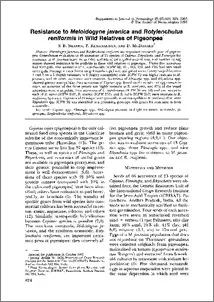Resistance to Meloidogyne javanica and Rotylenchulus reniformis in Wild Relatives of Pigeonpea

Abstract
Meloidogynejavanica and Rotylenchulu4 reniformis are important nematode pests of pigeonpea. Greenhouse evaluation of 66 accessions of 25 species of Cajanus, Rhynchosia, and Flemingia for resistance to M. javanica based on number and size of galls, galled area of root, and number of egg masses showed resistance to be available in these wild relatives of pigeonpea. Thirty-five accessions had ~<10 galls. Five accessions of C. scarabaeoides (ICPW 92, 101, 103, 128, and 133) had very small or no galls. Damage indices (based on gall number, gall size, and galled area of root) ranged between 1 and 8 on a 1 (highly resistant) to 9 (highly susceptible) scale. ICPW 92 was highly resistant to M. javanica, and 38 other accessions were resistant. Accessions of Flemingia spp. and Rhynchosia spp. showed greater susceptibility than accessions of Cajanus spp. Based on the number of egg masses on roots, no accession of the three genera was highly resistant to R. reniformis, and 83% of the tested accessions were susceptible. Two accessions of C. scarabaeoides (ICPW 38 and 92) and one accession each of R. aurea (ICPW 210), R. minima (ICPW 237), and R. rotMi (ICPW 257) were resistant to R. reniformis. Species of Cajanus and Flemingia were generally more susceptible to R. reniformis than were Rhynchosia spp. ICPW 92 was identified as a promising genotype with genes for resistance to both nematodes
